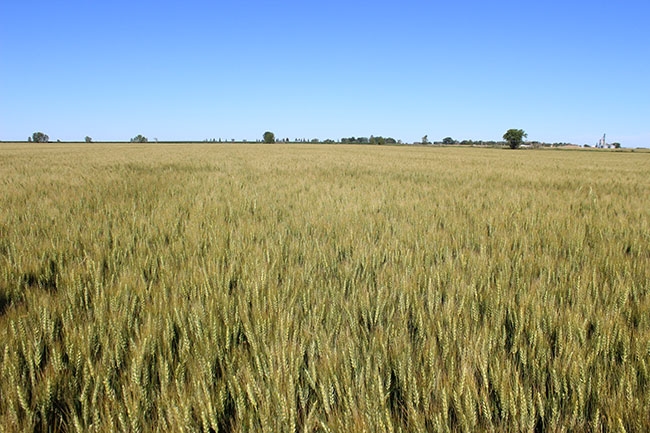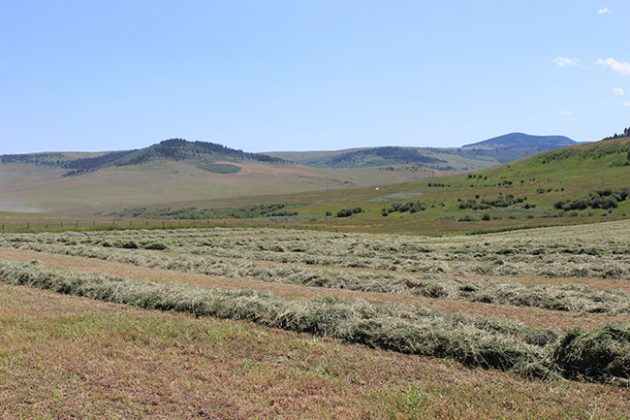
Features
Agronomy
Sustainable fertilizer management
Developing sustainable cropping systems is complex and must integrate the management of soil, water, nutrients and various pest management practices.
July 24, 2018 By Ross H. McKenzie PhD P. Ag
 An adequately fertilized spring wheat field. Developing sustainable cropping systems is complex
An adequately fertilized spring wheat field. Developing sustainable cropping systems is complexThe agricultural cropping systems in Canada rely heavily on commercial fertilizer inputs to optimize crop yields and to replace nutrients removed from soil. Canadian crop production would decline by more than 50 per cent in just a few years without the use of commercial fertilizers.
Commercial fertilizers increase crop production, which contributes to increased organic matter (OM) addition to soil. Increased soil organic matter content increases soil quality.
It’s important to fully understand the potential positive and negative effects of fertilizers on soil, water and air.
Soil quality
Maintaining or improving soil quality is an important part of sustainable crop management. Soil quality refers to the long-term ability of soil to function in order to sustain plant and animal productivity, maintain or enhance water and air quality and support human health and habitation. In other words, a cropping practice we use today would be sustainable if it was used for the next 200 years without negative impacts on soil, air or water quality. Indicators of soil quality include soil OM level, total soil nutrient levels, soil nutrient turnover rates, microbial activity and abundance and various physical and chemical characteristics, such as soil pH.
All farmers should monitor the quality of soils to assess the long-term effects and impacts of their cropping practices. Generally, conventional agricultural practices over the last century have resulted in declines in soil quality. However, more recently, more sustainable cropping practices like continuous cropping, reduced tillage, direct seeding and modest commercial fertilizer use to replace soil nutrients have all promoted soil quality improvement.
Sustainable nutrient inputs
Nitrogen (N) and phosphorus (P) are the two most commonly used fertilizers, followed by potassium (K) and sulphur (S). All commercial fertilizers require production and transportation. Nitrogen fertilizer can be fixed from the air with energy, as the main production cost. Other nutrients must be mined and processed into soluble, plant available forms.
World abundance of P and K is finite. Availability of P and K fertilizers likely will not be a concern in our lifetimes, but the International Plant Nutrition Institute estimates world reserves of rock phosphate will only last about 200 years, and in the United States, reserves may be exhausted in less than 25 years. World reserve estimates for K project they will last for more than 300 years. For agriculture to be sustainable in the long-term, we must think about how we can conserve fertilizer nutrient sources for future generations. We must make the best use of our limited nutrient sources and ensure nutrients are applied to crops with the highest efficiency.
Evaluating nutrient sources
Commercial fertilizers, animal manures and nutrients released from soil organic matter are common plant nutrient sources for crops. All plants take up nutrients in inorganic form; plants cannot differentiate whether nutrients come from commercial fertilizer or organic matter breakdown. For example, plants cannot differentiate between nitrate (NO3) released from organic materials versus from commercial fertilizers. However, the timing of nutrient release varies greatly among commercial fertilizers, manure and organic matter breakdown, which is important from a plant requirement standpoint.
Most nutrients in commercial fertilizers are usually in soluble, inorganic form and are either available for plant uptake after application or become available within a few weeks of application. Immediate availability of a nutrient can be beneficial to a crop providing a “pop up” effect to help the crop off to a healthy start after emergence. Starter fertilizer with or near the seed at germination can be very beneficial when nutrient availability is low in early spring, or when soil is cool, nutrient availability is reduced and OM decomposition rates are slow.
Fertilizers are often applied before or at the time of planting, when the crop does not need the quantity of nutrients applied. This can decrease fertilizer use efficiency and possibly contribute to nutrient leaching, runoff problems or nutrient losses to the atmosphere. In recent years, new commercial fertilizers have been developed with slow-release characteristics to more closely match nutrient release with crop nutrient uptake patterns. Slow-release fertilizers or nutrients from organic materials can be beneficial, providing a more continuous, low concentration of nutrients throughout the growing season so a crop takes up what it needs as nutrients become available. Organic materials must undergo decomposition by soil micro-organisms, which takes time. Additionally, the release rate is affected by the type of organic matter, soil biological activity and soil and environmental conditions – particularly moisture and temperature.
The various types of fertilizers used by farmers and when and how they are applied can have profound and long-lasting effects on uptake efficiency by crops, as well as environmental effects on soil, water or air quality.
Fertilizer effects of soil pH
Soil pH is a soil quality factor farmers should monitor over the long-term. Soil pH is a measure of hydrogen (H+) and hydroxyl (OH-) ion concentration in soil. It refers to the acidity (low pH) or alkalinity (high pH) of soil and is measured in pH units. Ideally, soil pH should be between 6 and 8. Some commercial fertilizers contribute to acidification of soil. Lower soil pH can reduce availability of some plant nutrients, such as phosphate. Lower pH will reduce the viability of nitrogen-fixing rhizobium bacteria, which in turn will affect production of N-fixing pulse crops and legume forages such as alfalfa. As soil pH declines, aluminum and manganese in soil become more soluble. A drop in pH can result in an increase in soluble aluminum and manganese, which can be toxic to plants and will reduce crop yields. Aluminum stifles root growth, which restricts access to water and nutrients.
Nitrogen fertilizers are commonly used in Canada and contribute to soil acidification. Fertilizers of greater concern include urea [CO(NH2)2], anhydrous ammonia (NH3), mono-ammonium phosphate (NH4H2PO4), ammonium sulfate [(NH4)2SO4], urea ammonium nitrate (a liquid mixture of urea and ammonium nitrate) and ammonium polyphosphate (NH4PO3). Other fertilizers such as elemental sulphur (So) are also acidifying. As the N fertilizers undergo conversion to nitrate (NO3) , H+ ions are released into the soil solution, causing soil pH to decline. The pH of Prairie soils has been declining over the last 20 to 30 years, primarily due to repeated N fertilizer application, particularly in no-till cropping systems. Soil pH decline has been most notable in the zero- to three-inch depth in fields that have been in no-till. With continued N and S fertilizer use, soil pH will gradually decline over time.
Fortunately, significant decline in soil pH has not severely affected soil productivity in most areas across Canada – yet. All farmers need to closely monitor soil pH change. As pH approaches 5.5 or less, action may be necessary.
In no-till fields with a soil pH of less than 5.5 in the zero- to three-inch depth, but with a soil pH of greater than 6.5 in the three- to six-inch depth, cultivating to mix the zero- to three and three- to six-inch depths may rectify the problem for up to 10 years. However, if soil pH is less than 6 in the three- to six-inch soil depth, using tillage to mix the two layers may have limited benefits.
The most common and effective practice to raise soil pH is applying agricultural lime (calcium carbonate). Liming is an expensive and time-consuming process. To determine the correct lime rate needed to raise soil pH to 6.5, have a soil test lab do a lime requirement test. The solubility of lime is relatively low, so when it’s applied to the soil surface, it must be very well incorporated to react with soil and effectively raise soil pH over a few years.
In agricultural regions where acidic soil is becoming an increasing concern, farmers will need to become more proactive to monitor soil pH and deal with soil acidity.
Fertilizer effects on the atmosphere
Nitrogen fertilizer can be lost to the air by denitrification and cause serious environmental concerns. Denitrification is the reduction of nitrate-nitrogen (NO3-N) to nitrous oxide (N2O), which is lost to the atmosphere. One molecule of nitrous oxide has the same negative greenhouse gas effect as almost 300 molecules of carbon dioxide.
Soils that are warm, saturated with water and have nitrate present are the most prone to significant denitrification losses. Denitrification occurs more commonly on medium- and fine-textured soils. When soil pores are filled with water, displacing air from the soil, soil micro-organisms strip off the oxygen from nitrate, converting it to nitrous oxide. Considerable soil nitrate-nitrogen can be lost due to denitrification. For farmers, denitrification means economic loss of nitrogen fertilizer and crop yield loss. For society, denitrification means negative effects on air quality and the environment.
Farmers can be very proactive to reduce denitrification on their farms, using various types of products to slow down N fertilizer release or using slow-release N fertilizers, such as environmentally smart nitrogen (ESN). Nitrogen fertilizer rates, timing and placement can all be used to help minimize N loss from soil. For example, N fertilizer should not be fall-applied to areas subject to saturated soil conditions in the spring or to low-lying land subject to wet spring conditions. Because of possible denitrification losses, it is generally recommended that fall-applied nitrogen be banded in the ammonium form and applied as late as possible once the soil is cold so the nitrogen remains in the ammonium form. Denitrification losses do not occur if the fertilizer nitrogen remains in the ammonium form.
Using summerfallow in a cropping system is not advised, as the available N is present in the nitrate form and quite vulnerable to losses under excess moisture conditions.
Fertilizer affects water quality
Leaching of nitrate nitrogen or sulphate occurs when excess water moves soluble, mobile nutrients from the surface soil, through the root zone and down into groundwater. When leaching occurs, nitrate-N and sulphate-S are lost from the root zone, reducing the utilization of N and S by crops. Excess precipitation will cause leaching anytime from early spring to late fall, particularly in sandy soils. Leaching of nitrate into groundwater has human and livestock health concerns. When nitrate is higher than 10 parts per million (ppm) in groundwater, it is unacceptable for human consumption. Fertilizer management practices used to prevent denitrification are often applicable to prevent leaching, such as slow-release N products and fertilizers.
Nutrients in runoff water from farmland can seriously affect surface water quality. N and P fertilizers can significantly contribute to contamination of surface waters. Soluble nutrients and nutrients attached to sediments can be carried in surface runoff. Nutrients in organic matter carried into surface water will also negatively affect surface water quality. The result is eutrophication. Overgrowth of aquatic plants caused by excess nitrates and phosphates results in a shortage of oxygen in the water, leading to death of aquatic life. The United States Department of Agriculture notes one pound of phosphate in surface water will contribute to the production of up to 500 pounds of blue-green algae.
On-farm fertilizer management practices are critically important to minimize nutrients in surface runoff and make our cropping practices more sustainable in the long-term.
The many benefits of sustainable nutrient management
Sustainable nutrient management practices must be the goal of every farmer. Sustainable practices:
- Conserve our fertilizer resources for future generations.
- Improve soil quality over time.
- Can reduce farm inputs and costs.
- Minimize negative effects of fertilizers on air and water quality.
- Ensure Canadian farms are economically viable.
- A range of sustainable cropping practices will need to be developed to ensure more efficient use of fertilizer resources for long-term sustainable crop production across Canada’s diverse soil and agro-ecological regions.
